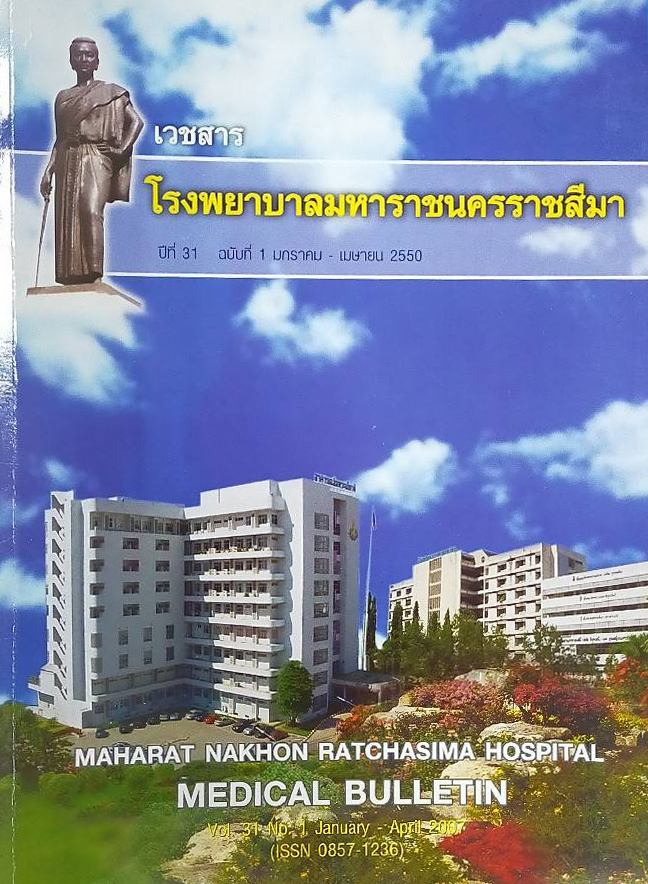Baterial Meningitis in Children at Maharat Nakhon Ratchasima Hospital : a 5-year Review
Main Article Content
Abstract
Background: Bacterial meningitis is a serious problem in children. In Maharat Nakhon Tatchasima Hospital, there has never been previous study about bacteria sofar. Objective: To study the causative bacteria of meningitis, the pattern of sensitivity in culture positive organism, especially in H. influenzae and S. pneumoniae and acute complications during hospitalization. Patients & Methods: Cases of un enigitis admitted during 1 January 2000-31 December 2004 Pediatric department were reviewed, 0-15 yrs. Results: Seventy-five were enrolled in this study and there were 46 bacterial meningitis, 27 aseptic meningitis, 1 eosinophilic meningitis and 1 ungroupable. In bacterial meningitis group, H. influenzae was the most common causative agent (19.6 %), S. pneumoniae was the second (13%) and E. coli was the third. H. influenzae resisted to ampicillin 25% and S. pneumoniae resisted to penicillin 75%. However, the minimum inhibitory concentration of these organism to cefotaxime was < 0.5 mg/ml, so high dose cefotaxime was effective. In this study, one patient died because of S. pneumoniae septicemia and disseminated intravascular coagulopathy. Another 18 cases had acute complications during hospitalization such as subdural collection 11 cases, hydrocephalus 5 cases, cerebritis & empyema and syndrome of inappropriate anti-diuretic hormone 3 cases, pneumonia 2 cases and ventriculitis 1 case. This study revealed that C-reactive protein was more predictive in aseptic meningitis rather than bacterial one. Conclusion: H. influenza, S. pneumoniae and E. coli were the major causes of bacterial meningitis in children at Maharat Nakhon Ratchasima Hospital. Concerning to drugs resistant, S. pneumoniae resisted to penicillin at intermediated level.
Article Details

This work is licensed under a Creative Commons Attribution-NonCommercial-NoDerivatives 4.0 International License.
References
ทวี โชติพิพิทยสุนนท์. โรคติดเชื้อของระบบประสาทส่วนกลางในเด็ก. ใน: ทวี โชติพิทยสุนนท์,อังกูร เกิดพาณิช. รังสิมา โล่ห์เลขา, บรรณาธิการ. Update on Pediatric Infectious Disease 2004. กรุงเทพฯ: รุ่งศิลปิการพิมพ์ (1997); 2547. หน้า 203-22.
จุฑารัตน์ เมฆมัลก็กา. What is new in pediatric CNS infection? ใน : ทวี โชติทยสุนนท์, อังกูร เกิดพาณิช. รังสิมา โล่ท์เลขา, บรรณาธิการ. Update on Pediatric Infectious Disease 2005. กรุงเทพฯ: รุ่งศิลปการพิมพ์ (1997); 2548. หน้า 179-97.
อัญชลี เชื่องศรีกุล, สมศักดิ์ โลห์เลขา. เชื่อหุ้มสมองจากเชื้อแบคทีเรียชนิดเฉียบพลันในเด็ก. วารสารกุมารเวชศาสตร์ 2534 : 30: 116-21.
Rerks-Ngarm S, Treleaven SC, Chunsuttiwat S, Muangchana C,Jolley D, Brooks A, et al. Prospecive populationbased incidence of Hacmophilus influenzae type b meningitis in Thailand. Vaccine 2004; 22: 975-83.
Tunkel AR, Hartman BJ, Kaplan SL, Kaufman BA, Roos KL, Scheld WM, et al. Practice guidelines for the management ofbacterial meningitis. Clin Infect Dis 2004; 39: 1267-84.
Chotpitayasunondh T. Bacterial meningitis in children: etiology and clinical features, an 11-year review of 618 cases. Southeast Asian J Trop Med Public Health 1994; 25: 107-15.
McCracken GH Jr. Bacterial meningjis In: Kaplan SL, editor. Current therapy in pediatric infectious disease. St. Louis: Mosby Year Book; 1993. p.144-51.
Bradley IS, Kaplan SL Klugman KP, Leggiadro RJ. Consensus: management of infections in children caused by Sireptococcus pneumoniae with decreased susceptibility to penicillin. Pediatr Infect Dis 1995; 14:1037-41
American Academy of Pediatrics. Dexamethasone therapy for bacterial meningitis in infants and children In: Peter G, editor. 1997 Red book: report of the Committee on Infectious Disease. 24"ed. Elk Grove Village, IL: American Academy of Pediatrics; 1997. p.620-2.


